 |
|
|---|
 |
|
|---|
C.J. McMahon, Jr., Ransom Weaver, and Seamus S. Woods
 |
|---|
| CONTENTS |
To address these issues, the University of Pennsylvania is developing a multimedia-based course for introductory materials science and engineering that serves as both a comprehensive one-semester materials education course for non-materials science and engineering majors and as an introduction to the subject for prospective future topic majors. The course employs computer-presented tutorials that can be utilized in several ways: as a replacement for classroom lectures in courses where the class meetings are devoted to studio-type active learning, as a supplement to classroom lectures that are illustrated by the animations provided, as a basic course in institutions where faculty from other branches of science or technology serve as coaches for materials science and engineering, or as a self-study course for those who must pursue the subject on their own.

 A demonstration of the tutorials is available for download. The demonstration consists of three pages from the chapter on phase diagrams: the lever rule, relative amounts of
A demonstration of the tutorials is available for download. The demonstration consists of three pages from the chapter on phase diagrams: the lever rule, relative amounts of  and and
 , and solute redistribution. The demonstration module is available in both Macintosh format as a
binhexed self-extracting archive (3.3 Mb) and Windows format as a
zipped file (2.9 Mb). , and solute redistribution. The demonstration module is available in both Macintosh format as a
binhexed self-extracting archive (3.3 Mb) and Windows format as a
zipped file (2.9 Mb).
|
This project is attempting to face the challenges of introductory-level courses by putting the entry-level transfer of information at the disposal of the student, who can then control the pace of delivery, including the ability to stop and re-play portions of the lecture that seem unclear at first. A dissenter might say that this is supposed to be the function of a textbook, and it is true that a small fraction of students can use a textbook effectively for this purpose. However, experience shows that most students are unable to do this, whether for reasons of time, motivation, ability to absorb new information from a printed medium, or others. In any case, a textbook is a mono-medium that has great difficulty in presenting moving or evolving processes.
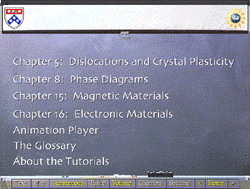 |
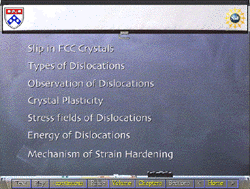 |
| Figure 1. The chapters in the tutorial. | Figure 2. Each chapter is divided into sections. |
To develop a tutorial, an initial version of the script and a storyboard for the illustrations are developed first; the next step is constructing the animations. Next, the script is revised to adjust to the final form of the animations; the cues for the illustrations are inserted; the script is recorded; and, finally, the audio, illustrations, and other components are integrated in the finished tutorial.
As in a book, the tutorials are divided into chapters (Figure 1), and each chapter is divided into sections (Figure 2). Each section contains up to 25 screens called pages, and any page can be identified and accessed by way of the tabs that display a yellow title at the top of each screen (Figure 3). The interface is a blackboard on which the navigation controls; the words or phrases that a lecturer would typically write on the board (Figure 4); and the diagrams, photographs, animations, video clips, and derivations that appear during the play-through presentation of a page (Figure 5) are displayed.
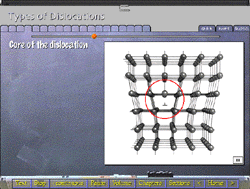 |
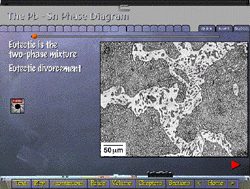 |
| a | b |
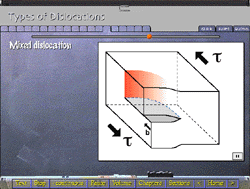 |
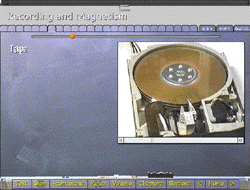 |
| c | d |
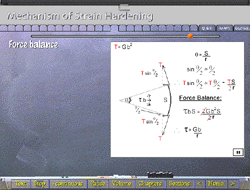 |
A QuickTime video clip (4 Mb .mov file) and an audio file (258 kb .au file) from one tabbed segment in the recording and magnetism section (Figure 5d) can be played now. |
| e |
At the end of each section is a set of questions for review (Figure 6), and the answer to each question can be seen by clicking on the question. Every page is linked to the interactive glossary (Figure 7), so that the student can look up any term that is likely to need some further explanation. Any page may be marked as a place holder or for review, and this is saved between sessions in a preference file.
The topics in boldface are complete and comprise the content of the first CD-ROM; the interactive glossary is also included. The topics in italic are presently under development and will comprise the next CD-ROM, which is anticipated for release in early 1999.

 A demonstration copy of the animation player is available for download. Featured are examples from the chapter on dislocations and crystal plasticity. The player is available in both Macintosh format as a binhexed self-extracting archive (1.4 Mb) and Windows format as a zipped file (1.2 Mb).
A demonstration copy of the animation player is available for download. Featured are examples from the chapter on dislocations and crystal plasticity. The player is available in both Macintosh format as a binhexed self-extracting archive (1.4 Mb) and Windows format as a zipped file (1.2 Mb).
|
Nevertheless, an analysis of the questions on the final exam showed that the average score on this material (62) was not much different from the average for the material covered in the lecture format (67), which had been covered at the normal pace and had mostly been treated in the two-hour exams during the term. This early version of the compact disk lacked some of the refinements added later, such as the slider (the red ball shown in several figures) and the question-and-answer list at the end of each section (Figure 6). Given the students' responses, it was concluded that the approach was feasible.
The improved version of the chapter on magnetic materials was tested by a group of volunteer students who had no prior knowledge of the material during the spring term of 1998. Four students learned the material (in a preliminary way, as they probably would have in preparing for a studio class) by using the CD-ROM, and four others learned it from the textbook. All eight had access to the question-and-answer list—four on the CD-ROM and the other four in printed form. They were given a test comprising ten of the 61 questions on the list. The averaged scores were 59 for the CD-ROM group and 56 for the textbook group. Given the small sample size, the difference is not statistically significant. The real difference came in the averaged estimated time that each group spent on the subject: 3.1 hours for the CD-ROM group and 4.1 hours for the textbook group. In addition, the former group expressed a preference for learning from the CD-ROM over the textbook method in a follow-up questionnaire. This provides encouragement that the multimedia tutorial will be a viable method of getting students to prepare for the studio classes, which would depend heavily on prior preparation. (Of course, some coercion will presumably be needed and applied in the form of short daily quizzes.)
ABOUT THE AUTHORS
C.J. McMahon, Jr., earned his Sc.D. in physical metallurgy at Massachusetts Institute of Technology in 1963. He is currently a professor in the Department of Materials Science and Engineering at the University of Pennsylvania. Dr. McMahon is a fellow of TMS.
Ransom Weaver earned his B.A. in literature at the University of Pennsylvania in 1990. He is currently a graduate student in Arabic studies at the University of Pennsylvania.
Seamus S. Woods is an undergraduate in the Department of Materials Science and Engineering at the University of Pennsylvania.
For more information or to acquire a complimentary copy of the CD-ROM (instructors only), contact C.J. McMahon, Jr., Department of Materials Science and Engineering, University of Pennsylvania, 3231 Walnut Street, Philadelphia, Pennsylvania 19104; (215) 898-7979; fax (215) 573-2128; e-mail cmcmahon@lrsm.upenn.edu.
To order the first CD-ROM (Introduction to Engineering Materials: The Bicycle and the Walkman) after it has become available, contact Merion Media, c/o Whitman Distribution Center, 10 Water Street, Lebanon New Hampshire 03766; (800) 353-3730; fax (603) 448-2576.
Direct questions about this or any other JOM page to jom@tms.org.
| Search | TMS Document Center | Subscriptions | Other Hypertext Articles | JOM | TMS OnLine |
|---|